Discover 20 hidden attractions, cool sights, and unusual things to do in Bergamo (Italy). Don't miss out on these must-see attractions: Santa Maria Maggiore, Museo Matris Domini, and Museo di Scienze Naturali Enrico Caffi. Also, be sure to include Bergamo Cathedral in your itinerary.
Below, you can find the list of the most amazing places you should visit in Bergamo (Lombardy).
Table of Contents
Santa Maria Maggiore
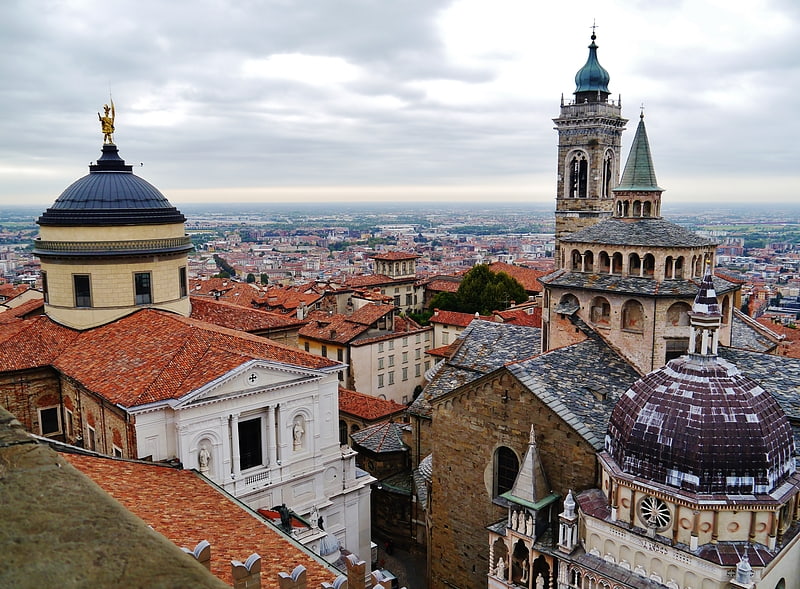
1137 church with gilded baroque interior. The Basilica of Santa Maria Maggiore is a major church in the upper town of Bergamo, Northern Italy.[1]
Address: Piazza Duomo, 24129 Bergamo
Museo Matris Domini
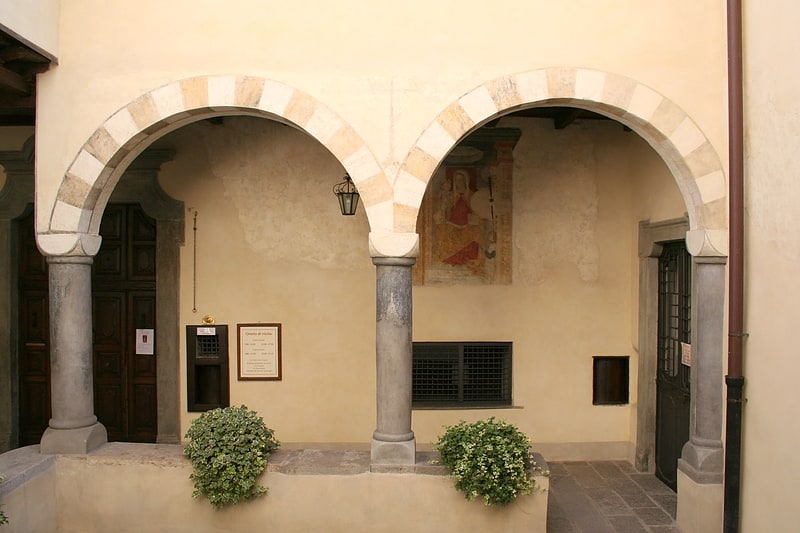
Museum in Bergamo, Italy. The Museo Matris Domini is housed in the oldest section of the Dominican convent of the same name, situated in the city centre of Bergamo, Italy. It is administered by the nuns of the foundation.
The museum preserves a series of 13th and 14th Century frescoes which were uncovered in a 1973 restoration of what was thought to have been the old refectory and a small church within the monastery. The reappearance of these paintings was highly significant as they are amongst the earliest surviving examples of wall painting in the province of Bergamo and indeed in Lombardy as a whole.
Outstanding for their pictorial and emotion qualities are fragments from what must have been a depiction of the Last Judgment: the Just, the Blessed, two Angels with trumpets (which are of particular beauty), Saint Peter Enthroned, and Hell, all attributed to the Master of the Tree of Life.
There is another series of frescoes of great emotive and narrative quality, representing Jesus among the Doctors, the Baptism, the Virgin and Child Enthroned, Saint Catherine of Alexandria upon the Wheel, Saint Martin and the Pauper, Jesus entering Jerusalem, and the Miracle of the reanimation of Napoleone Orsini by Saint Dominic, showing the young man falling from his horse. These works, together with the Visitation, have been attributed to the so-called First Master of Abbey of Chiaravalle, an anonymous artist active in Lombardy circa 1320-30, and known only through these works, as well as frescoes in San Marco, Milan and in the eponymous Abbey of Chiaravalle.
The Visitation is a particularly striking image because of its freshness and for the expressiveness of the faces of the Virgin and Saint Elizabeth, painted by the Master with great intelligence and sensitivity. A 16th-century fresco depicting Saint Dominic (the patron of the monastery) with other saints is also featured in the museum.[2]
Address: Via Antonio Locatelli 77, 24121 Bergamo
Museo di Scienze Naturali Enrico Caffi
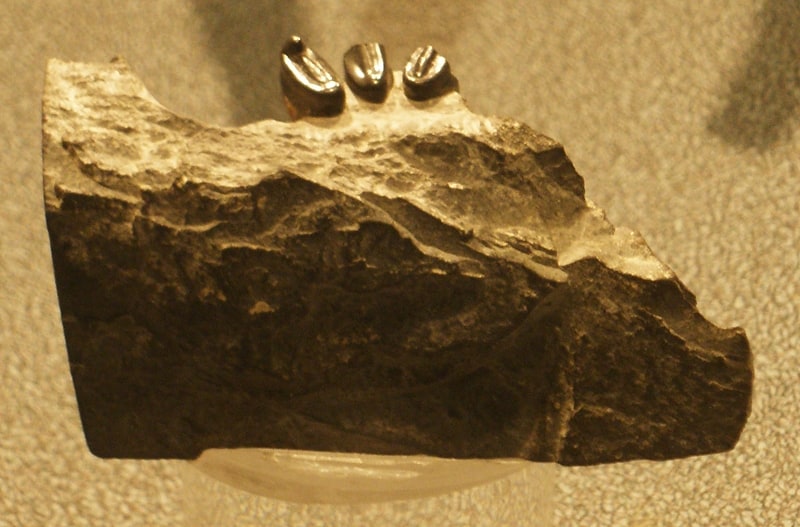
Also known as: Museo di scienze naturali
Museum in Bergamo, Italy. Civic Museum of Natural Science Enrico Caffi is a natural history museum in Bergamo, Italy. The museum has more than 55,000 artifacts, fossils, animal and plant specimens. The museum is founded in 1918 and, after multiple moves, is currently located at Piazza Cittadella. The museum also hosts a library and provide education activities for schools in the region.[3]
Address: Piazza della Cittadella, 24129 Bergamo
Bergamo Cathedral

Also known as: Duomo di Bergamo
Historic cathedral with notable art. Bergamo Cathedral is a Roman Catholic cathedral in Bergamo, Italy, dedicated to Saint Alexander of Bergamo, patron saint of the city. It is the seat of the Bishop of Bergamo.[4]
Address: Piazza Duomo, 24129 Bergamo
Accademia Carrara

Prominent art museum with a gift shop. The Accademia Carrara, officially Accademia Carrara di Belle Arti di Bergamo, is an art gallery and an academy of fine arts in Bergamo, in Lombardy in northern Italy. The art gallery was established in about 1780 by Giacomo Carrara, a Bergamasco collector or conoscitore of the arts. The academy of fine arts was added to it in 1794. The school was recognised by the Ministero dell'Istruzione, dell'Università e della Ricerca, the Italian ministry of education, in 1988.[5]
Address: Piazza Giacomo Carrara, 82, 24121 Bergamo
Fortified city of Bergamo
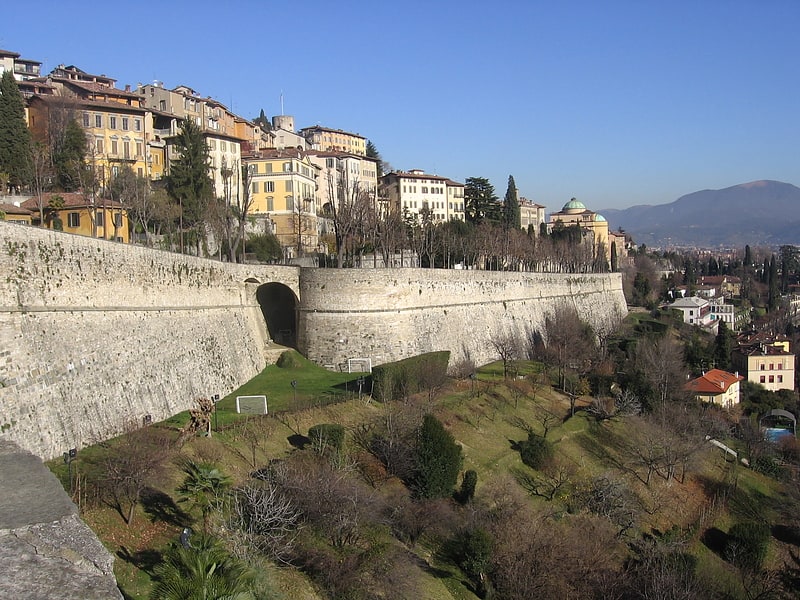
Venetian walls of Bergamo - are the city walls surrounding the old, located on the hill part of the Italian city of Bergamo. They were built by the Venetian Republic in the 16th century. They are one of the most characteristic Bergamo tourist buildings and attractions.
Cappella Colleoni

Grand 15th-century chapel with frescoes. The Cappella Colleoni is a chapel and mausoleum attached to the Basilica of St. Mary Major in the northern Italian city of Bergamo.
Dedicated to the saints Bartholomew, Mark and John the Baptist, it was built between 1472 and 1476 as the personal shrine for the condottiere Bartolomeo Colleoni, a member of one of the city's most notable families, and his beloved daughter Medea. The site chosen was that of the church's sacristy, which was demolished by Colleoni's soldiers. Whether or not the demolition was authorized by church administrators remains the subject of scholarly debate among Italian historians.
The design was entrusted to Giovanni Antonio Amadeo, whose plan respected the style of the church, as can be seen from the octagonal tambour of the dome and in the lantern cusp, as well as in the use of polychrome marbles.[6]
Address: Piazza Duomo, 5, 24129 Bergamo
Pozzo Bianco
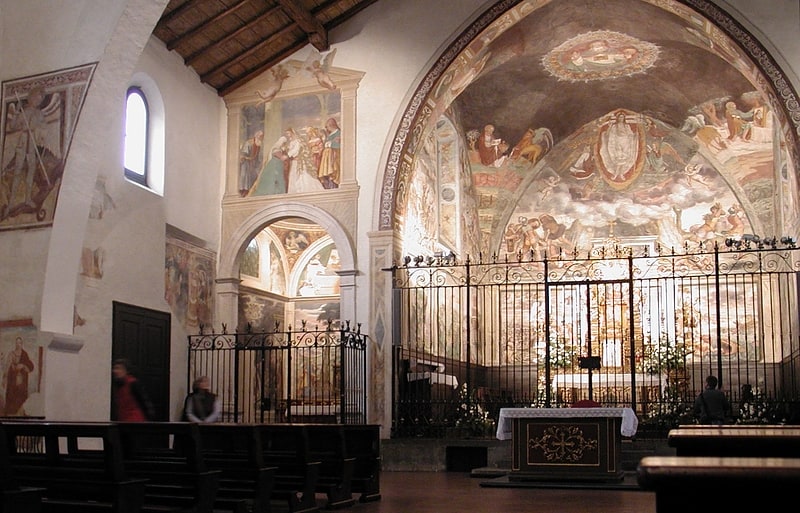
Church in Bergamo, Italy. San Michele al Pozzo Bianco is a church in the upper town of Bergamo, on a small piazza of the same name, near Porta Sant’Agostino, on Via Porta Dipinta. The church is now in a corner next to the frescoed house of the vicar, entered by a large rounded arch. The vicar's house has an external fresco attributed to Giacomo Scanardi.[7]
Address: Via Porta Dipinta, 45, 24129 Bergamo
Teatro Donizetti
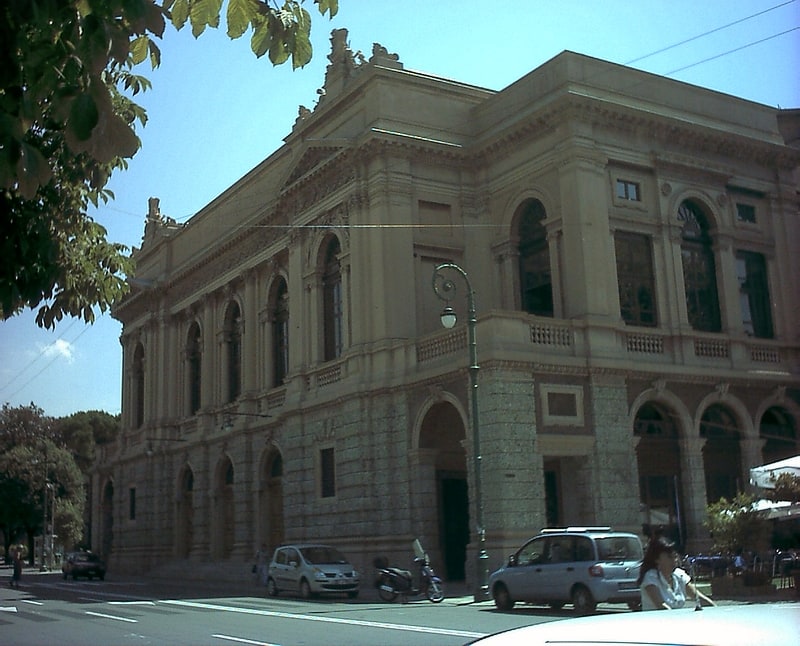
Also known as: Teatro Gaetano Donizetti
Theatre in Bergamo, Italy. The Teatro Donizetti is an opera house in Bergamo, Italy. Built in the 1780s using a design by architect Giovanni Francesco Lucchini, the theatre was originally referred to as either the Teatro Nuovo or Teatro di Fiera. The first opera to be mounted at the theatre, Giuseppe Sarti's Medonte, re di Epiro, was in 1784 while the opera house was still under construction. The official opening of the house, under the name the Teatro Riccardi, did not occur until 24 August 1791 with a production of Pietro Metastasio's Didone abbandonata set to music by multiple composers, including Ferdinando Bertoni, Giacomo Rampini, Johann Gottlieb Naumann, Giuseppe Gazzaniga, and Giovanni Paisiello.
In 1797 the original theatre was destroyed by a fire, possibly by arson. Lucchini was contracted again to design a new structure to replace the old one and the new house opened on 30 June 1800. The structure uses a horseshoe shape with three tiers of boxes and two galleries.
In 1897 the name of the theatre was changed to the Teatro Gaetano Donizetti (now shortened to Teatro Donizetti) on the occasion of the centenary of the composer's birth. Donizetti was born in Bergamo's Borgo Canale quarter and his first opera, Il Pigmalione (composed 1816), was given its world premiere at the theatre on 13 October 1960.
Adjacent to the theater is a park with the Monument to Donizetti.[8]
Address: Largo Gianandrea Gavazzeni, 2, 24121 Bergamo
Sant'Andrea
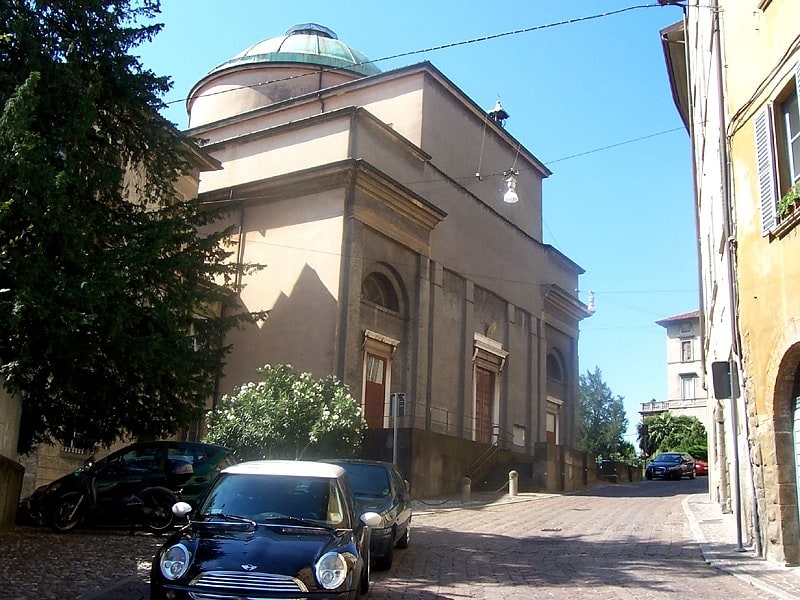
Church in Bergamo, Italy. Sant'Andrea is a Neoclassic church in Bergamo, rebuilt by Ferdinando Crivelli in 1837. On the main altar, is Enthroned Madonna with child and Saints Eusebius, Andrew, Domno, and Domneone, painted in 1536-7 by Il Moretto and a Nativity by Giovanni Paolo Cavagna. Other paintings here are by Palma il Giovane, Enea Salmeggia, Giovanni Giacomo Barbelli, Padovanino, a ‘’Deposition’’ by Andrea Previtali, and others.[9]
Address: Via Porta Dipinta, 39, 24129 Bergamo
Orto Botanico di Bergamo "Lorenzo Rota"
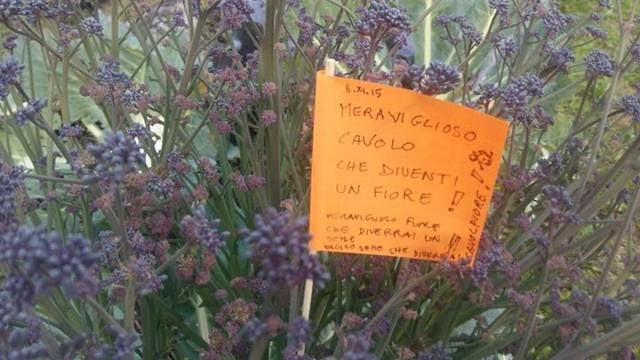
Also known as: Orto botanico Lorenzo Rota
Garden with over 900 plant species. The Orto Botanico di Bergamo "Lorenzo Rota" is a botanical garden located at the top of a long stairway from Scaletta di Colle Aperto, Bergamo, Lombardy, Italy. It is open daily during the warmer months.
The garden was established in 1972, and named in honor of physician and botanist Lorenzo Rota. It was at first predominantly an alpine garden, but after 1989 began collaboration with the Museum of Natural Sciences and broadened its collection. In 1993, the garden became an integral part of the museum.
Although smaller than a soccer field, the garden now contains more than 900 species arranged into 23 collections, including:
- Alpine - Abies alba, Achnatherum calamagrostis, Alnus viridis, Carlina acaulis, Corydalis lutea, Dryas octopetala, Hieracium pilosella, Horminum pyrenaicum, Larix decidua, Pinus mugo, Rhamnus alpinus, Rhaponticum scariosum, Rhododendron hirsutum, Rubus idaeus, Picea abies, Potentilla grandiflora, Primula hirsuta, Primula auricula, Ranunculus thora, Saxifraga cotyledon, and Vaccinium myrtillus.
- Lombardy - more than half of the garden's species, including Allium ursinum, Arum italicum, Aruncus dioicus, Asarum europaeum, Betula pendula, Campanula elatinoides, Campanula raineri, Carex pendula, Carpinus betulus, Convallaria majalis, Daphne mezereum, Doronicum pardalianches, Erythronium dens-canis, Euphorbia amygdaloides, Fagus sylvatica, Lathyrus vernus, Leucojum vernum, Omphalodes verna, Osmunda regalis, Pulmonaria officinalis, Ranunculus ficaria, Quercus cerris, Sanguisorba dodecandra, Saxifraga petraea, Saxifraga vandelli, Scilla bifolia, Sorbus aucuparia, Taxus baccata, and Telekia speciosissima.
- Exotic species - including Amsonia tabernaemontana, Bletia hyacinthina, Brunnera macrophylla, Colocasia antiquorum, Corylopsis spicata, Davidia involucrata, Euonymus alatus, Grevillea rosmarinifolia, Raphiolepis indica, Sarcococca confusa, Staphylea colchica, and Telekia speciosa.
Address: Scaletta Colle Aperto, 24129 Bergamo
Tempietto di Santa Croce
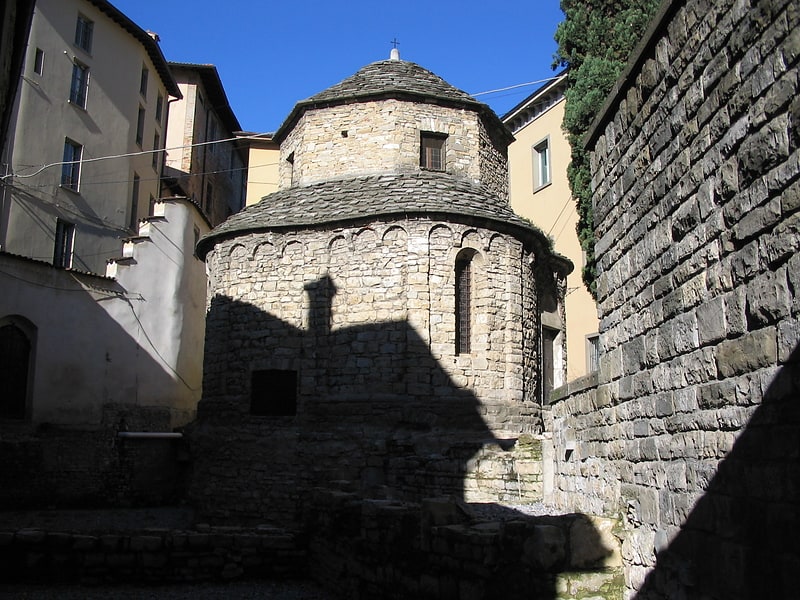
Chapel in Bergamo, Italy. The Tempietto di Santa Croce is a small octagonal Romanesque chapel found in the upper city of Bergamo, near the Santa Maria Maggiore. The original building was constructed in the first half of the 11th century, though first documentation of the structure dates to 1133. Other Romanesque structures in the province include the Rotonda di San Tomè, the Basilica di Santa Giulia, and the Priorato di Sant'Egidio.[11]
Campanone
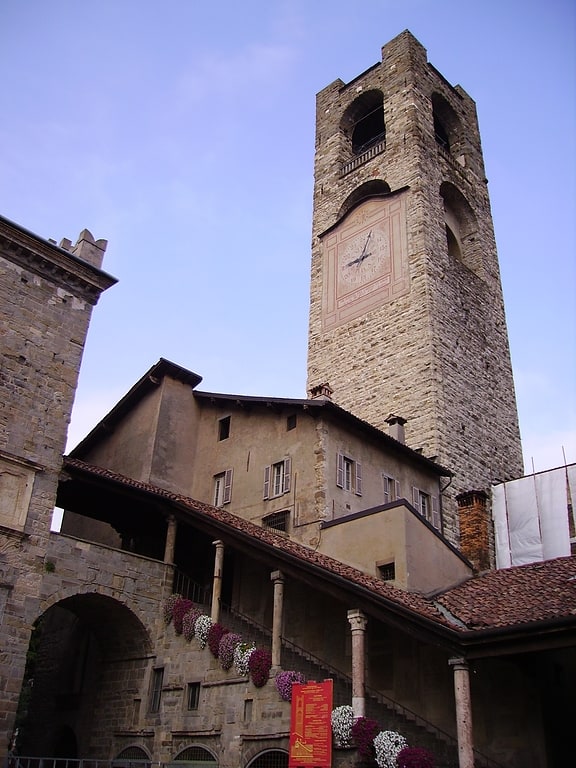
The city tower in Bergamo - a historic building, located in the upper city, in Bergamo, at Piazza Vecchia. It is located near Palazzo della Ragione and Palazzo del Podestà. It is sometimes called Campanone because of the great bell placed on it. Initially, the tower measured 38 m in height, but from the Middle Ages it was partly rebuilt until it reached 54 m. It is the highest tower in the city. From its top you can admire the panorama of Bergamo and the surrounding area. Typical medieval features of the building make it one of the city's most important monuments.
Parco dei Colli di Bergamo

Park in Italy. Parco dei Colli di Bergamo is a natural park in the province of Bergamo, Lombardy, northern Italy.[12]
Santi Bartolomeo e Stefano
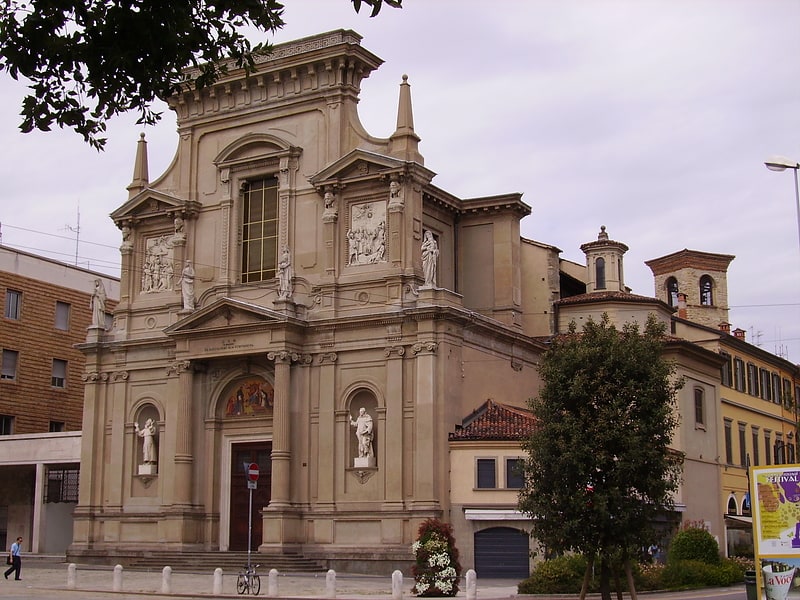
Catholic church in Bergamo, Italy. Santi Bartolomeo e Stefano is a Baroque-style, Roman Catholic church located at number 1 Largo Belotti in Bergamo in the Lombardy region of Italy. The church is associated with a Dominican convent and stands about a block away from the Teatro Donizetti.[13]
Address: Largo Bortolo Belotti, 1, 24121 Bergamo
Torre del Gombito

The Gombito Tower is located in the upper part of the city of Bergamo, at the intersection of the street of the same name, Via San Lorenzo and Via Mario Lupo, the most central and important crossroads of the ancient city.
Battistero

The baptistery of Bergamo is the building designated for the baptismal rite, since 1898 located in Piazza del Duomo in front of the basilica of St. Alexander. It was built in the 14th century by Giovanni da Campione.
Monastero di Astino
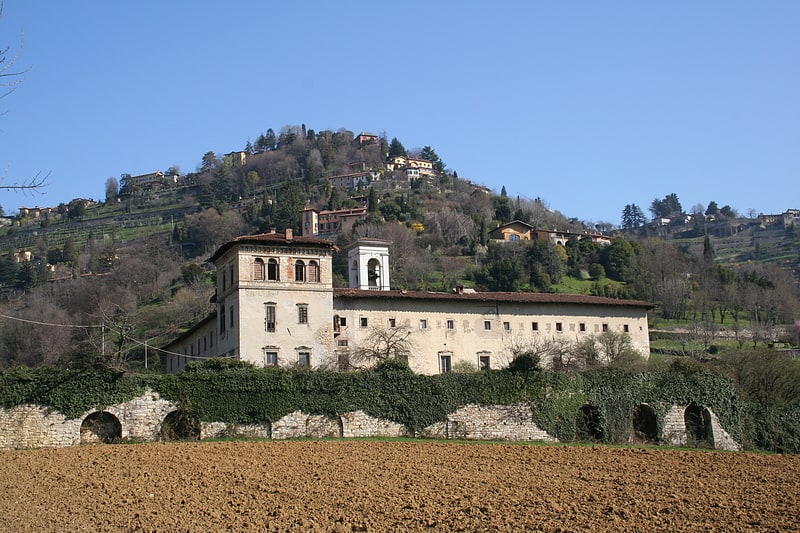
Monastery in Bergamo, Italy. Astino Abbey is a former Roman Catholic monastery in the Astino Valley, in the Province of Bergamo, region of Lombardy, Italy. It is no longer active. The buildings were restored in 2015.[14]
San Benedetto

Monastery in Bergamo, Italy. San Benedetto is a Renaissance-style, Roman Catholic church located in Via Sant'Alessandro #51 in Bergamo, region of Lombardy, Italy.
The church was designed in 1500s by Pietro Isabello. The church was refurbished in 1756 - 1757. It acquired at this time a silver altarpiece for the main altar; this was melted down by the Napoleonic authorities during the Cisalpine Republic.
The two main altarpieces depicting the Assumption of the Virgin by Giovanni Battista Moroni and San Stefano by Calisto Piazza were transferred to the Pinacoteca Brera in Milan. The monks still remained in the monastery, restoring the convent to life in 1827. In 1841 a new marble altar was completed by Giacomo Bianconi. The walls still retain the Renaissance-style frescoes.
Further reconstructions occurred in the 20th and 21st centuries. The adjacent cloistered convent of the Benedictines, still active, has been recently restored.[15]
Address: Via Sant'Alessandro, 53, 24122 Bergamo
Sant'Alessandro in Colonna

Catholic church in Bergamo, Italy. Sant'Alessandro in Colonna is a Baroque style, Roman Catholic church located on Via Sant'Alessandro in Bergamo, region of Lombardy, Italy.[16]
Address: Via Sant'Alessandro 35, 24122 Bergamo